Stochastic Optical Reconstruction Microscopy (STORM)
- PMID: 28678417
- PMCID: PMC5663316
- DOI: 10.1002/cpcy.23
Stochastic Optical Reconstruction Microscopy (STORM)
Abstract
Super-resolution (SR) fluorescence microscopy, a class of optical microscopy techniques at a spatial resolution below the diffraction limit, has revolutionized the way we study biology, as recognized by the Nobel Prize in Chemistry in 2014. Stochastic optical reconstruction microscopy (STORM), a widely used SR technique, is based on the principle of single molecule localization. STORM routinely achieves a spatial resolution of 20 to 30 nm, a ten-fold improvement compared to conventional optical microscopy. Among all SR techniques, STORM offers a high spatial resolution with simple optical instrumentation and standard organic fluorescent dyes, but it is also prone to image artifacts and degraded image resolution due to improper sample preparation or imaging conditions. It requires careful optimization of all three aspects-sample preparation, image acquisition, and image reconstruction-to ensure a high-quality STORM image, which will be extensively discussed in this unit. © 2017 by John Wiley & Sons, Inc.
Keywords: single molecule localization microscopy (SMLM); stochastic optical reconstruction microscopy (STORM); super-resolution fluorescence microscopy.
Copyright © 2017 John Wiley & Sons, Inc.
Figures

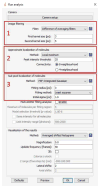
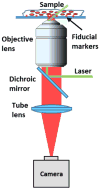

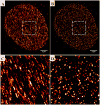
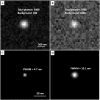

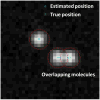






Similar articles
-
Direct stochastic optical reconstruction microscopy (dSTORM).Methods Mol Biol. 2015;1251:263-76. doi: 10.1007/978-1-4939-2080-8_14. Methods Mol Biol. 2015. PMID: 25391804
-
Stochastic optical reconstruction microscopy (STORM) in comparison with stimulated emission depletion (STED) and other imaging methods.J Neurochem. 2015 Nov;135(4):643-58. doi: 10.1111/jnc.13257. Epub 2015 Sep 14. J Neurochem. 2015. PMID: 26222552 Review.
-
Technical review: types of imaging-direct STORM.Anat Rec (Hoboken). 2014 Dec;297(12):2227-31. doi: 10.1002/ar.22960. Epub 2014 Jul 4. Anat Rec (Hoboken). 2014. PMID: 24995970 Review.
-
Stochastic optical reconstruction microscopy (STORM): a method for superresolution fluorescence imaging.Cold Spring Harb Protoc. 2013 Jun 1;2013(6):498-520. doi: 10.1101/pdb.top075143. Cold Spring Harb Protoc. 2013. PMID: 23734025
-
Super-resolution imaging of subcortical white matter using stochastic optical reconstruction microscopy (STORM) and super-resolution optical fluctuation imaging (SOFI).Neuropathol Appl Neurobiol. 2018 Jun;44(4):417-426. doi: 10.1111/nan.12426. Epub 2017 Aug 3. Neuropathol Appl Neurobiol. 2018. PMID: 28696566 Free PMC article.
Cited by
-
Fast widefield scan provides tunable and uniform illumination optimizing super-resolution microscopy on large fields.Nat Commun. 2021 May 24;12(1):3077. doi: 10.1038/s41467-021-23405-4. Nat Commun. 2021. PMID: 34031402 Free PMC article.
-
Inferiority complex: why do sensory ion channels multimerize?Biochem Soc Trans. 2022 Feb 28;50(1):213-222. doi: 10.1042/BST20211002. Biochem Soc Trans. 2022. PMID: 35166323 Free PMC article. Review.
-
High-resolution microscopy for imaging cancer pathobiology.Curr Pathobiol Rep. 2019;7(3):85-96. doi: 10.1007/s40139-019-00201-w. Epub 2019 Jul 11. Curr Pathobiol Rep. 2019. PMID: 32953251 Free PMC article.
-
Recent Progress in Small Spirocyclic, Xanthene-Based Fluorescent Probes.Molecules. 2020 Dec 16;25(24):5964. doi: 10.3390/molecules25245964. Molecules. 2020. PMID: 33339370 Free PMC article. Review.
-
Recent advances in targeting obesity, with a focus on TGF-β signaling and vagus nerve innervation.Bioelectron Med. 2025 Apr 30;11(1):10. doi: 10.1186/s42234-025-00172-x. Bioelectron Med. 2025. PMID: 40301996 Free PMC article. Review.
References
-
- Bates M, Huang B, Dempsey GT, Zhuang X. Multicolor super-resolution imaging with photo-switchable fluorescent probes. Science. 2007;317:1749–1753. Available at: http://www.ncbi.nlm.nih.gov/pmc/articles/PMC2633025/pdf/nihms-88394.pdf. - PMC - PubMed
-
- Bates M, Jones SA, Zhuang X. Preparation of photoswitchable labeled antibodies for STORM imaging. Cold Spring Harb Protoc. 2013a;2013:540–541. Available at: http://www.ncbi.nlm.nih.gov/pubmed/23734027. - PubMed
-
- Bates M, Jones SA, Zhuang X. Stochastic optical reconstruction microscopy (STORM): a method for superresolution fluorescence imaging. Cold Spring Harb Protoc. 2013b;2013:498–520. Available at: http://www.ncbi.nlm.nih.gov/pubmed/23734025. - PubMed
-
- Betzig E, Patterson GH, Sougrat R, Lindwasser OW, Olenych S, Bonifacino JS, Davidson MW, Lippincott-Schwartz J, Hess HF. Imaging intracellular fluorescent proteins at nanometer resolution. Science. 2006;313:1642–1645. - PubMed
-
- Dani A, Huang B, Bergan J, Dulac C, Zhuang X. Superresolution Imaging of Chemical Synapses in the Brain. Neuron. 2010;68:843–856. Available at: http://dx.doi.org/10.1016/j.neuron.2010.11.021. - DOI - PMC - PubMed
MeSH terms
Substances
Grants and funding
LinkOut - more resources
Full Text Sources
Other Literature Sources
Research Materials

